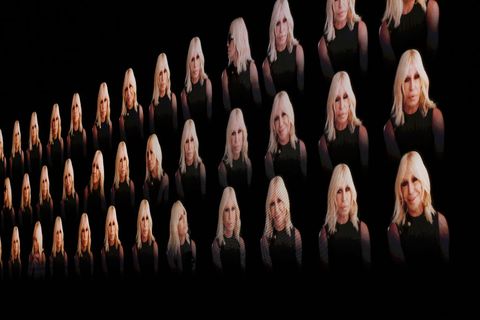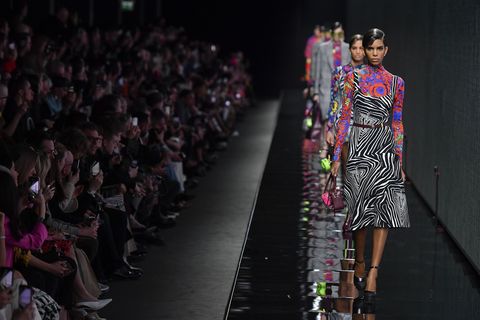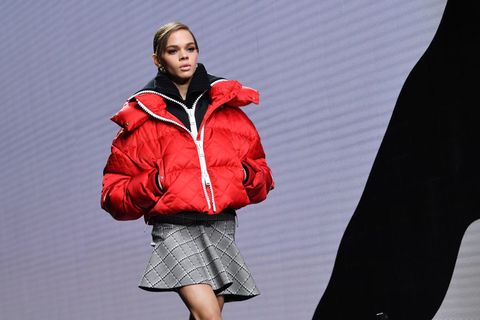After months of lockdown, Milan had recently re-opened, with workers flooding back to offices, and Donatella Versace was happy to be back in the office (though she had picked up some Zoom skills in quarantine.) Below, as part of ELLE’s look at the future of fashion, the designer speaks about how this moment is making her push even harder for sustainability; the drawbacks of digital shows, and why she thinks smaller, seasonless collections are the future of fashion. (In July, after this interview took place, she put this into practice by showing Versace Flash, a co-ed capsule collection.)
How do you envision fashion transforming in this difficult time? How can we use this moment to change it for the better?
I’ve had a lot of time to think about this, and my first answer is: Nothing’s ever going to be the same. These past three months I’ve been thinking, thinking, thinking – we have really had time to think about our jobs and about fashion. How can we make fashion different and more in touch with life, with the new normal, which is completely different than before?
We started the sustainability discussion before COVID. But for example, for me, going out in Milan the first day, I felt the air was much more clean. I saw the sky was finally blue. In years and years, I had never seen Milan so clear. There were no cars. No people around. I don’t think I was the only person who saw that. So sustainability is what I’m going to concentrate on most. I think we are going to be out of place, showing things that are not sustainable. Now, not 100 percent of fashion can be sustainable. It isn’t possible to do 100 percent. Also, the most sustainable things are very, very expensive. We have a large range of customers, and we have to think of a young customer with not much money. But we are working on this. I have a big team working on this and giving me answers. And again, I want to underline that I have been working diligently on this topic for a few years. And now, step by step, we will get to a point when the environmental impact of fashion will be drastically reduced. So, this is my goal.
I’m convinced that nothing is going to be the same ever again. So fashion, finally, is going to change. It’s going to have different rules, if we can call those rules. Because, I mean, it was getting too predictable. We had Fashion Week in September; men’s fashion week in June, and it never changed for years and years. When something never changes, it’s not relevant anymore, and the most important thing is to keep fashion relevant. How to do that is another discussion.
Another thing I want to concentrate on is a seasonless collection. Something very light when it’s snowing outside; it’s ridiculous. This kind of delivery – the wrong season in the wrong season – needs to stop. You need to be free to, if it’s a beautiful spring day, go into the store and find something for spring, not find a coat. Or a fur, though we don’t use fur anymore. That’s the immediate reaction to fashion: ‘I want to wear it now.’
Going back to what you said about the pace of the industry for a second, there have been a couple of open letters and manifestos: Alessandro Michele wrote about this, Dries van Noten published an open letter that was signed by many different designers, as I’m sure you saw, and they were talking about these questions of changing the pace of fashion, changing the way the seasons work to avoid, like you said, the bathing suit-in-December problem. Do you think that’s something the rest of the fashion industry will get behind?
All of the designers realized what we want, but we couldn’t ask for it because the industry behind us wouldn’t follow us: Seasonless, smaller collections, more often. Instead of doing a fashion show where you show 70 or 80 looks, I’d like to do 30 looks for men and women and do them more often. When I have the right idea, to be able to construct a small collection around this idea, and then in two to three months you do more looks. We should be more free to create in the moment we have the idea.
This content is imported from Instagram. You may be able to find the same content in another format, or you may be able to find more information, at their web site.
Right, and I think that people are reconsidering right now, how much they’ve consumed in the past, and taking stock of what they have, wanting to invest in quality.
Absolutely. I think use-and-throw-away fashion, it’s finished. I think people who are investing money in fashion, they want something that can stay in their wardrobe and wear season after season, and be relevant, always. So quality is so important. If you really want to call yourself a luxury brand, a luxury brand is quality. Other luxury brands have used cheap fabrics for cost reasons and cheap ways to sew the clothes, and declared, ‘This is a luxury brand.’ No, that’s not possible anymore. If you are a luxury brand, you do luxury clothes. That doesn’t mean luxury has to be very, very expensive. You can work around that. You cannot wear an outfit for [just] one or two seasons – it needs to live in your wardrobe.
Italy has an unbelievable tradition of quality and artisanship; the most beautiful things I own were all made in Italy! I’m really hoping that, with everything the country has gone through, that you’re able to continue that tradition.
The ateliers that we use for production, they all were in trouble with the pandemic, and a lot of them were very small, with only 10 or 15 people working there. So we took care of this, in order to help give them more business, so that they did not die. Because if this small craftsmanship business dies, fashion is dead. Fashion has a meaning in society. Fashion helps a man or a woman to feel better, to feel stronger, and to feel relevant in some way. Not because you are well-dressed, but because you are a relevant person: your attitude, your intelligence, the way you explain yourself. We were very careful to help so that these small businesses don’t die – so that Italian craftsmanship doesn’t die.
The conversation about diversity and inclusion in fashion has only become more urgent in this moment. What does the industry need to be doing to address that?
We need to be inclusive, we need to be courageous, and we need to give a chance to different people to come in, learn, and express themselves. There are a lot of talented people that deserve a voice, to be seen, and given a chance.
Do you think digital shows will replace in-person shows, or do you feel that those are irreplaceable?
The emotion of a fashion show cannot be replaced digitally. That’s for sure. I don’t think you can “visit” emotion from your laptop; that’s impossible.
I was there for the supermodel moment that you did in 2017. That was something where, if you were in that room, it was unlike anything else, as opposed to seeing it on a screen. So I don’t think that’s going away. I have been interested in how people are finding workarounds now, but I do think we’ll probably go back to the traditional show. Are there different ways of doing things that you have been adopting?
I will go back to a traditional show, I think, but I’m going to put a little bit more technology into it. It will be a mix. During this lockdown, if it weren’t for technology, we wouldn’t have seen each other. I never thought we were going to work so much from home via technology, Zoom discussions. But I did it; you adapt yourself. But when we opened the office and saw each other again, it was a totally different emotion. You need to be able to touch the fabric, to see the outfit on a real person to understand what you’re doing. So, yes [to] digital, but not completely.
Campaigns are completely changing as well, with Zoom campaigns or even avatars as models. Is that something that you think will become more common, or again, do you think that’s just of this time?
Maybe people will do more of this, but that’s not the main thing. You cannot show your clothes on Zoom. I don’t believe that. You need your team, a studio, and a photographer. It has to be a combination of week in the digital world and the real world. People are real, also, digitally. [laughs] But I want to feel people around me.
This interview has been edited and condensed for clarity.
Read More On The Future of Fashion
This content is created and maintained by a third party, and imported onto this page to help users provide their email addresses. You may be able to find more information about this and similar content at piano.io









